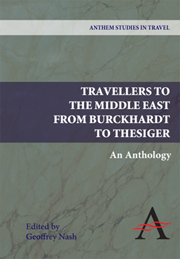Book contents
- Frontmatter
- Contents
- Acknowledgements
- Introduction
- PART ONE THE COMING OF EMPIRE 1800–1879
- The Ottoman Empire and Egypt
- Arabia
- 1 Travels in Arabia
- 2 Travels in Arabia
- 3 Personal Narrative of a Pilgrimage to Al-Madinah and Meccah
- 4 Narrative of a Year's Journey Through Central and Eastern Arabia
- 5 A Pilgrimage to Nejd
- 6 Travels in Arabia Deserta
- Persia
- PART TWO COLONIALISM AND RESISTANCE 1880–1950
- Bibliography
5 - A Pilgrimage to Nejd
from Arabia
Published online by Cambridge University Press: 05 March 2012
- Frontmatter
- Contents
- Acknowledgements
- Introduction
- PART ONE THE COMING OF EMPIRE 1800–1879
- The Ottoman Empire and Egypt
- Arabia
- 1 Travels in Arabia
- 2 Travels in Arabia
- 3 Personal Narrative of a Pilgrimage to Al-Madinah and Meccah
- 4 Narrative of a Year's Journey Through Central and Eastern Arabia
- 5 A Pilgrimage to Nejd
- 6 Travels in Arabia Deserta
- Persia
- PART TWO COLONIALISM AND RESISTANCE 1880–1950
- Bibliography
Summary
Granddaughter of Lord Byron, Anne Isabella Noel became Lady Anne Blunt on her marriage with Wilfrid Scawen Blunt in 1869. Together they formed a travelling couple, embarking on a series of journeys in the Muslim world beginning with Anatolia (1873) Algeria (1874) the Egyptian Western Desert (1876), Mesopotamia and Persia (1877–78) and the deserts of Central Arabia (1879). Lady Anne reports the last two in Bedouin Tribes of the Euphrates (1879) and A Pilgrimage to Nejd (1881). Her travel writings were developed from notes taken on the spot, and rewritten material initially based on impressions and dialogues (Hout DLB/174: 44). Wilfrid added introductions and also acted as ‘editor’, by no means an unusual practice given the unequal gender relations of the period, which required: ‘a woman's representation of the exotic Other … to be authorized by a male orientalist’, and demarcated roles ‘between the woman as fieldworker and the man as analytical theorist’ (Behdad 1994: 95, 97). These writings propose an ideal of an Arab aristocracy of the desert, initially stimulated by Palgrave and later by the Blunts' contact with sheykhs and emirs on their travels. They established a winter retreat, Sheykh Obeyd, in the desert outside Cairo from which Wilfrid was banned for several years after his involvement with the nationalist side in the Urabi revolution of 1881–2. They also assembled a stud of Arabian horses at Crabbet, their Sussex estate.
- Type
- Chapter
- Information
- Travellers to the Middle EastAn Anthology, pp. 73 - 77Publisher: Anthem PressPrint publication year: 2009



